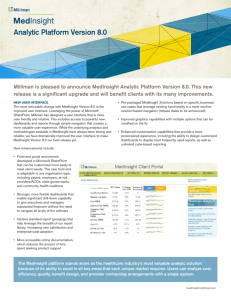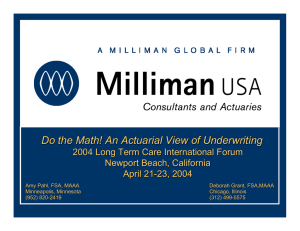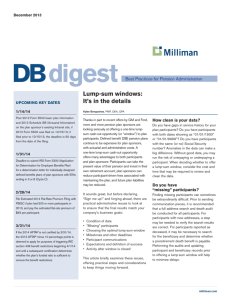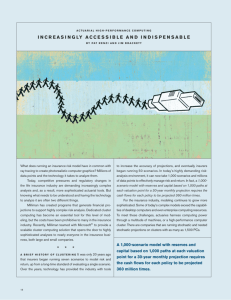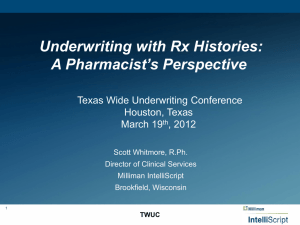Handout 1 - Casualty Actuarial Society
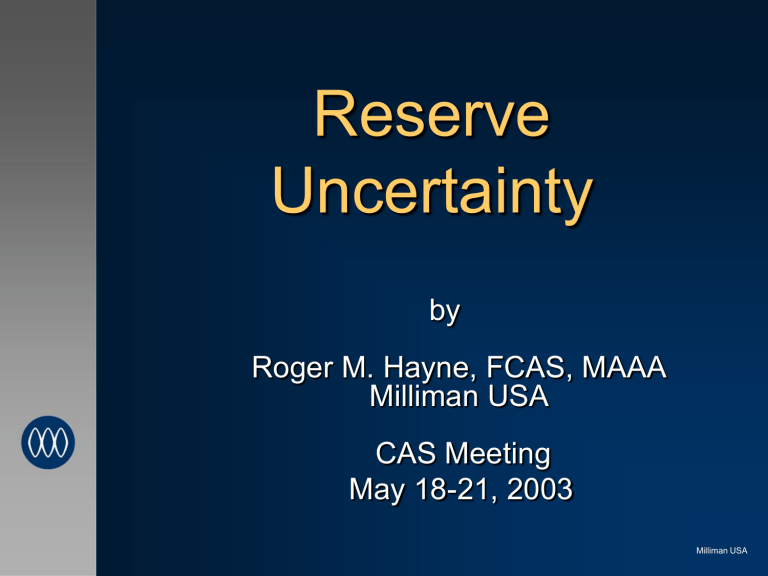
Reserve
Uncertainty
by
Roger M. Hayne, FCAS, MAAA
Milliman USA
CAS Meeting
May 18-21, 2003
Milliman USA
Reserves Are Uncertain?
Reserves are just numbers in a financial statement
What do we mean by “reserves are uncertain?”
– Numbers are estimates of future payments
Not estimates of the average
–
Not estimates of the mode
Not estimates of the median
Not really much guidance in guidelines
Rodney Kreps has more to say on this subject
Milliman USA
Let’s Move Off the
Philosophy
Should be more guidance in accounting/actuarial literature
Not clear what number should be booked
Less clear if we do not know the distribution of that number
There may be an argument that the more uncertain the estimate the greater the
“margin”
Need to know distribution first
Milliman USA
“Traditional” Methods
Many “traditional” reserve methods are somewhat ad-hoc
Oldest, probably development factor
– Fairly easy to explain
– Subject of much literature
– Not originally grounded in theory, though some have tried recently
– Known to be quite volatile for less mature exposure periods
Milliman USA
“Traditional” Methods
Bornhuetter-Ferguson
– Overcomes volatility of development factor method for immature periods
– Needs both development and estimate of the final answer (expected losses)
– No statistical foundation
Frequency/Severity (Berquist,
Sherman)
– Also ad-hoc
– Volatility in selection of trends & averages
Milliman USA
“Traditional” Methods
Not usually grounded in statistical theory
Fundamental assumptions not always clearly stated
Often not amenable to directly estimate variability
“Traditional” approach usually uses various methods, with different underlying assumptions, to give the actuary a “sense” of variability
Milliman USA
Basic Assumption
When talking about reserve variability primary assumption is:
Given current knowledge there is a distribution of possible future payments
(possible reserve numbers)
Keep this in mind whenever answering the question “How uncertain are reserves?”
Milliman USA
Some Concepts
Baby steps first, estimate a distribution
Sources of uncertainty:
– Process (purely random)
– Parameter (distributions are correct but parameters unknown)
– Specification/Model (distribution or model not exactly correct)
Keep in mind whenever looking at methods that purport to quantify reserve uncertainty
Milliman USA
Why Is This Important?
Consider “usual” development factor projection method, paid by age k
C ik accident year i,
Assume:
–
–
–
There are development factors f i
E( C i,k+1
| C i1
, C i2
,…, C ik
)= f k such that
C ik
{ C i1
, C i2
,…, C iI
}, { C j1
, C j2
,…, C jI
} independent for i j
There are constants
k such that
Var( C i,k+1
| C i1
, C i2
,…, C ik
)= C ik
k
2
Milliman USA
Conclusions
Following Mack ( ASTIN Bulletin, v. 23, No.
2, pp. 213-225) f
ˆ k
j
1
C j k
1
1 j
C are unbiased estimates for the development factors f i
Can also estimate standard error of reserve
Milliman USA
Conclusions
Estimate of mean squared error ( mse ) of reserve forecast for one accident year:
i
C
ˆ
2 iI
1 I k I i
f
ˆ
ˆ k k
2
2
C
1 ik
1 j
1
C jk
Milliman USA
Conclusions
Estimate of mean squared error ( mse ) of the total reserve forecast:
i
I
2
s.e.
i
2
C
ˆ iI
I j i 1
C
ˆ jI
I
1 k I i
2
I
ˆ
1 k
2 n
1
C nk f
ˆ k
2
Milliman USA
Sounds Good -- Huh?
Relatively straightforward
Easy to implement
Gets distributions of future payments
Job done -- yes?
Not quite
Why not?
Milliman USA
An Example
Apply method to paid and incurred development separately
Consider resulting estimates and errors
What does this say about the distribution of reserves?
Which is correct?
Milliman USA
“Real Life” Example
Paid and Incurred as in handouts
(too large for slide)
Results
Paid
Case Reserve
Reserve Est.
$358,453 s.e.(Est.) 41,639
Incurred
$96,917
90,580
13,524
Milliman USA
A “Real Life” Example
100,000 150,000 200,000 250,000 300,000 350,000 400,000 450,000 500,000
Paid Incurred
Milliman USA
A “Real Life” Example
100,000 150,000 200,000 250,000 300,000 350,000 400,000 450,000 500,000
Paid Incurred Actual
Milliman USA
What Happened?
Conclusions follow unavoidably from assumptions
Conclusions contradictory
Thus assumptions must be wrong
Independence of factors? Not really (there are ways to include that in the method)
What else?
Milliman USA
What Happened?
Obviously the two data sets are telling different stories
What is the range of the reserves?
–
–
Paid method?
Incurred method?
–
–
Extreme from both?
Something else?
Main problem -- the method addresses only one method under specific assumptions
Milliman USA
What Happened?
Not process (that is measured by the distributions themselves)
Is this because of parameter uncertainty?
No, can test this statistically (from normal distribution theory)
If not parameter, what? What else?
Model/specification uncertainty
Milliman USA
Why Talk About This?
Most papers in reserve distributions consider
– Only one method
– Applied to one data set
Only conclusion: distribution of results from a single method
Not distribution of reserves
Milliman USA
Discussion
Some proponents of some statisticallybased methods argue analysis of residuals the answer
Still does not address fundamental issue; model and specification uncertainty
At this point there does not appear much (if anything) in the literature with methods addressing multiple data sets
Milliman USA
Moral of Story
Before using a method, understand underlying assumptions
Make sure what it measures what you want it to
The definitive work may not have been written yet
Casualty liabilities very complex, not readily amenable to simple models
Milliman USA
All May Not Be Lost
Not presenting the definitive answer
More an approach that may be fruitful
Approach does not necessarily have
“single model” problems in others described so far
Keeps some flavor of “traditional” approaches
Some theory already developed by the
CAS (Committee on Theory of Risk,
Phil Heckman, Chairman)
Milliman USA
Collective Risk Model
Basic collective risk model:
–
–
–
Randomly select N, number of claims from claim count distribution (often Poisson, but not necessary)
Randomly select N individual claims, X
1
, X
2
, …,
X
N
Calculate total loss as T =
X i
Only necessary to estimate distributions for number and size of claims
Can get closed form expressions for moments (under suitable assumptions)
Milliman USA
Adding Parameter
Uncertainty
Heckman & Meyers added parameter uncertainty to both count and severity distributions
Modified algorithm for counts:
– Select
from a Gamma distribution with mean 1 and variance c (“contagion” parameter)
– Select claim counts N from a Poisson distribution with mean
– If c < 0, N is binomial, if c > 0, N is negative binomial
Milliman USA
Adding Parameter
Uncertainty
Heckman & Meyers also incorporated a “global” uncertainty parameter
Modified traditional collective risk model
– Select
from a distribution with mean 1 and variance b
–
–
Select N and X
1
, X
2
, …, X
Calculate total as T =
N
X i as before
Note
affects all claims uniformly
Milliman USA
Why Does This Matter?
Under suitable assumptions the
Heckman & Meyers algorithm gives the following:
–
–
E( T ) = E( N )E( X )
Var( T )=
(1 +b )E( X 2 )+
2 ( b + c + bc )E 2 ( X )
Notice if b = c =0 then
– Var( T )=
E( X 2 )
– Average, T / N will have a decreasing variance as E( N )=
is large (law of large numbers)
Milliman USA
Why Does This Matter?
If b
0 or c
0 the second term remains
Variance of average tends to
( b + c + bc )E 2 ( X )
Not zero
Otherwise said: No matter how much data you have you still have uncertainty about the mean
Key to alternative approach -- Use of b and c parameters to build in uncertainty
Milliman USA
If It Were That Easy …
Still need to estimate the distributions
Even if we have distributions, still need to estimate parameters (like estimating reserves)
Typically estimate parameters for each exposure period
Problem with potential dependence among years when combining for final reserves
Milliman USA
An Example
Consider the data set included in the handouts
This is hypothetical data but based on a real situation
It is residual bodily injury liability under no-fault
Rather homogeneous insured population
Milliman USA
An Example
(Continued)
Applied several “traditional” actuarial methods
– Usual development factor
– Berquist/Sherman
– Hindsight reserve method
– Adjustments for
Relative case reserve adequacy
Changes in closing patterns
Milliman USA
An Example
(Continued)
Accident
Year Incurred
1986
1987
1988
1989
1990
1991
744
2,335
8,371
Devel.
2,143
Sev.
1,760
6,847 5,583
19,768 16,246
25,787
60,211
44,631
83,760
36,887
73,987
83,093 130,907 95,283
Reserve Estimates by Method
Paid
Pure Prem.
Hindsight
Adjusted
Incurred Devel.
1,909
5,128
13,451
1,687
5,128
14,428
394
2,348
10,391
1,936
CD Adjusted Paid
Sev.
1,842
6,000 5,790
17,352 16,433
Pure Prem.
1,950
5,220
13,399
Hindsight
675
2,301
8,001
29,232
61,846
95,185
32,199
62,974
78,616
26,048
55,734
39,241
79,667
36,431
70,246
79,573 154,268 87,625
28,512
57,192
84,688
19,174
43,286
72,157
Milliman USA
An Example
(Continued)
Now review underlying claim information
Make selections regarding the distribution of size of open claims for each accident year
– Based on actual claim size distributions
–
–
Ratemaking
Other
Use this to estimate contagion (c) value
Milliman USA
An Example
(Continued)
Accident Reserve Unpaid Single Claim Implied
Year Selected Std. Dev.
Counts Average Std. Dev.
c Value
1986
1987
1,357
4,260
1988 12,866
637
1,620
3,525
106
330
926
12,802
12,909
13,894
18,913
19,072
20,527
0.190
0.135
0.072
1989 30,212
1990 62,516
1991 90,014
6,428
10,198
19,166
1,894
3,347
4,071
15,951
18,678
22,111
23,566
27,595
32,666
0.044
0.026
0.045
Milliman USA
An Example
(Continued)
Thus variation among various forecasts helps identify parameter uncertainty for a year
Still “global” uncertainty that affects all years
Measure this by “noise” in underlying severity
Milliman USA
An Example
(Continued)
Accident Severity
Year Selected
1986 7,723
1987 8,501
1988
1989
1990
1991
Variance
Fitted
7,780
8,196
9,577
9,919
8,634
9,095
10,739 9,581
12,194 10,093
Estimate of 1/
0.993
1.037
1.109
1.091
1.121
1.208
0.019
Milliman USA
An Example
(Continued)
100,000 150,000 200,000 250,000
With Uncertainty Without Uncertainty Actual
300,000
Milliman USA
CAS To The Rescue
Still assumed independence
CAS Committee on Theory of Risk commissioned research into
– Aggregate distributions without independence assumptions
– Aging of distributions over life of an exposure year
Will help in reserve variability
Sorry, do not have all the answers yet
Milliman USA
